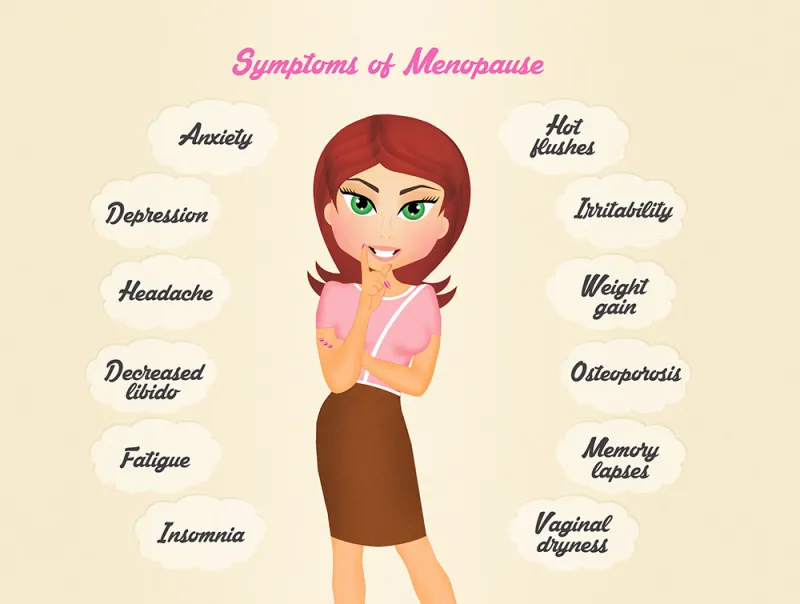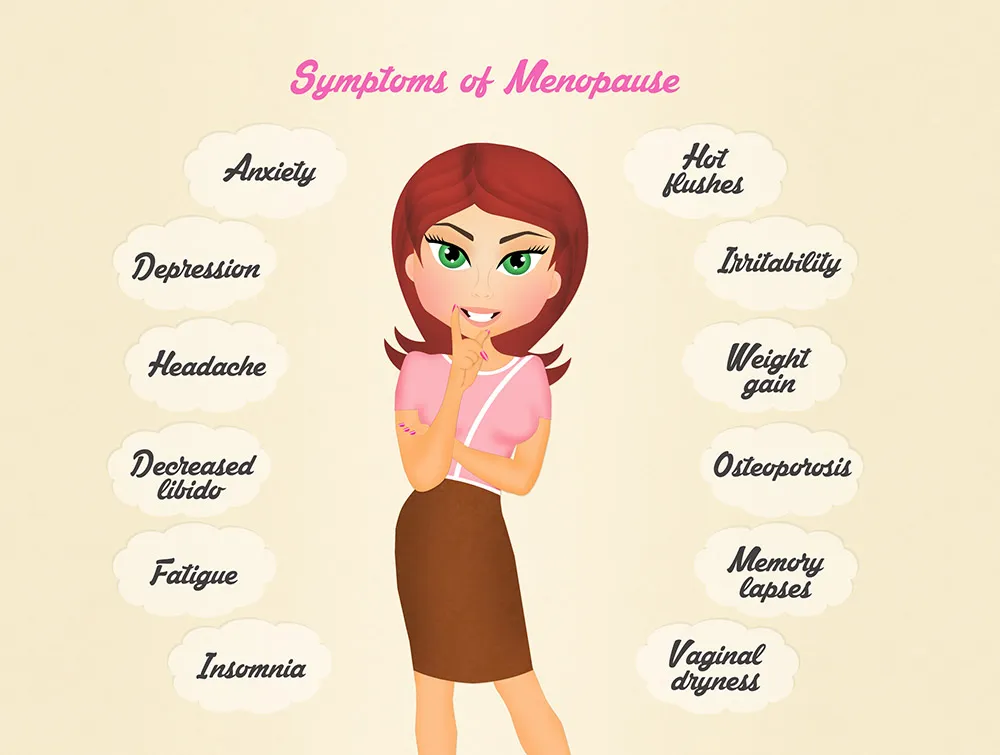Let’s talk about estrogen and menopause, along with mood and a few other things connected to the menstrual cycle. Here’s the problem: when you enter menopause, your hormones change – but you often don’t know exactly how or what to do. Why? A lot of the symptoms for high estrogen or estrogen dominance are very similar to low estrogen.
As a result, when you do research in the area of estrogen, you’re going to find a tremendous amount of unknowns, complexities, and confusions. Here, I’ll try to bring some clarity, explain what we definitely know for sure, and show you what course of action I recommend.
In the article:
Understanding Estrogen

People always talk about “estrogen,” but the reality is that there’s not just one estrogen. Instead, there are actually three different types of estrogen and they all have slightly different purposes:
-
Estradiol: The most common type of estrogen in women of childbearing age – and the primary estrogen when you’re not pregnant or in menopause.
-
Estriol: The main estrogen during pregnancy. This estrogen is anti-inflammatory, anti-cancer, and it has a lot of other helpful properties.
-
Estrone: The only estrogen your body makes after menopause (when menstrual periods stop). This estrogen increases your risk of certain types of cancer
Your ovaries make these three estrogens, but so do your adrenal glands. Particularly when you’re menopausal, your ovarian estrogen production goes way down and your adrenals essentially help pick up the slack.
If you’re menopausal and the adrenal glands are weak, however, you could start seeing all sorts of symptoms. This is not normal. It happens because the adrenals cannot back up the ovaries. When this happens, you’re going to see hormonal deficits and imbalances. This can create night sweats, hot flashes, bone loss, vaginal dryness, sleep problems, mood swings, weight gain, and other troublesome menopause symptoms for many women.
Causes of Low Estrogen
We do know, in certain studies, that when you’re depressed, you have lower estrogen levels. This lower estrogen can also occur:
-
At the first part of menstruation
-
At other points during the cycle of hormones in a given month
-
During menopause
In short, there are many times when estrogen hormone levels can go down naturally. To make things more complex, you can also have progesterone dropping down even further during menopause, which will exacerbate this relative higher level of estrogen. So even though estrogen goes down, the ratios are going to be off, making it appear that estrogen is relatively too high, even though it’s ultimately too low.
You can also get depression and anxiety if the estrogen levels are too high.
Something else to consider: there’s a certain structure in your brain called the amygdala. The amygdala is the part of the brain that has the most estrogen receptors. That little gland is responsible for all sorts of things related to stress. When it’s receiving too much or too little estrogen, it can affect your mood and put you in a state of anxiety or “doom and gloom.”
In short, estrogen levels have a huge effect on your mood and your cognitive state.
Causes of High Estrogen
Birth Control Pills
When someone takes birth control pills, which is mainly synthetic estradiol, it’s basically convincing the hypothalamus – the master gland in your brain – that you’re pregnant and that you don’t need to ovulate. With that comes a lot of other complications: increased risk for blood clots, stroke, headaches, high blood pressure, etc.
If you compound that by consuming a lot of foods that are not organic, smoking, and going through stress, you can really set yourself up for a lot of problems. These can even include gallstones and gallbladder disease.
Commercial Food Products
If you’re female, the most important thing that you can do to help balance estrogen is to avoid commercial foods that contain hormones. I’m talking specifically about commercial dairy and meats.
Instead, make sure that your meats, your dairy, and even your vegetables are mainly organic. Also, be sure to consume a good amount of cruciferous vegetables to clean these endocrine disruptors or estrogen mimickers and other hormones out of the liver and out of the body.
Compromised Liver or Digestive System
Your liver makes certain enzymes to help balance estrogen levels. If there’s too much, your liver will detoxify that excess. It’s the same thing with your gut. The gut has a very important purpose in making sure that there’s not too much estrogen in the body.
If you have a fatty liver, liver damage, or a problem with your digestive system (where you don’t have enough good bacteria and too much unfriendly bacteria), you can have a problem with an overload of estrogen in the system. That, in turn, can link to a whole bunch of other problems.
That includes suppression of the thyroid gland. High levels of estrogen hormone can inhibit thyroid function. Then, when the thyroid is low – as in hypothyroidism – that can also affect your metabolism, your liver’s ability to get rid of estrogen, and more.
What You Can Do

There are many “common” estrogen-balancing menopause therapies that many women try. In my opinion, these do not work very well. Such treatments include:
-
Hormone Replacement Therapy:
A lot of times, people will take straight HRT (hormone replacement therapy) as a solution. This can either by systemic HRT or local estrogen treatment, like low dose vaginal estrogen (products like Femring aim to do both). The reason hormone therapy works effectively is that it bypasses everything and goes right to the brain. It tells the brain “I got your message, I heard you, release the egg” thereby essentially turning off the hot flash. The problem, though, is that hormone therapy can give you side effects down the line, including breast cancer, stroke, heart disease, and other serious problems.
-
Treating the Menopausal Symptoms:
Alternatively, most people try to treat the menopause symptoms directly, and that quickly gets out of control. Think about it: if you’re taking a pill for collagen, one for bone loss, one for hot flashes, one for night sweats, etc., – you’re taking a lot of pills without actually fixing or improving the function that drives the adrenals.
We don’t recommend taking these routes. Instead, if you have any of these issues, there are a couple of things that you need to focus on in order to improve:
-
Go organic as much as possible. Of course, do keto and intermittent fasting. That way, you can reduce the sugar effect and the Fat Storing Hormone effect. Just make sure that everything you consume (or as much as possible) is high quality and organic, with lots of cruciferous vegetables.
-
Avoid dairy if you have problems with your menstrual cycle or you have too much estrogen. However, for most people – if they do grass-fed dairy – they’re going to be ok. But I would definitely not recommend milk or yogurt.
-
Iodine and boron: Iodine is very important in regulating estrogen. It helps to balance estrogen by lowering the bad estrogen and increasing the good. You can get it in sea kelp or seafood. The other mineral that’s very important in menopause is boron. Boron is really essential to help balance estrogen, and it’s really good for women who are going through menopause. I would also recommend it if you’re experiencing irritability or depression.
-
Vegetables: Cruciferous vegetables, kale, broccoli, brussel sprouts. There is also a product that I use called estrogen balance. You might want to look into it. It has something called DIM, which is a concentrated cruciferous. One pill is equivalent to two pounds of cruciferous vegetables.
In this process, there are a lot of factors to balance estrogen, whether it’s too high or too low.
There are many complexities and unknowns involved when you deal with menopause, the endocrine system, and estrogen. In any case, going organic is essential to protecting yourself in the future against the harmful effects of estrogen.
Up Next:







